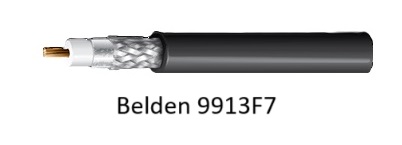Coaxial cables are widely used for transmitting signals in a range of applications, from cable TV and satellite signals to radio communications and Wi-Fi installations. Two of the most popular types of coaxial cables are RG6 and LMR-400, each with their own set of strengths and weaknesses.
LMR-400 is a high-performance coaxial cable that is often used in demanding applications where low signal loss and high shielding are required. It has a lower level of signal loss than RG6, which makes it a better choice for longer cable runs. It also has a higher level of shielding, which makes it more resistant to interference and distortion. However, it is more expensive and less flexible than RG6.
RG6, on the other hand, is a more cost-effective coaxial cable that is widely used for basic applications such as cable TV and satellite signals. It is more flexible than LMR-400 and has a higher level of attenuation, which can be an advantage in certain applications. However, it has a higher level of signal loss than LMR-400, which makes it less suitable for longer cable runs.
When choosing between RG6 and LMR-400, several factors should be considered. The type of signal being transmitted, the length of the cable run, and the environment in which the cable will be installed are all important considerations. Other factors include impedance, shielding, frequency range, temperature range, and connector compatibility.
In Dubai, UAE, there are several suppliers of both RG6 and LMR-400 coaxial cables. These suppliers can provide high-quality cables that meet the specific requirements of different applications. When choosing a supplier, it is important to consider factors such as product quality, pricing, delivery times, and customer support.
In summary, both RG6 and LMR-400 are high-quality coaxial cables that have their own unique set of strengths and weaknesses. By understanding these differences and considering the specific requirements of the application, it is possible to choose the best cable for the job and ensure reliable, high-quality signal transmission. In Dubai, UAE, there are several suppliers of both RG6 and LMR-400 coaxial cables who can provide high-quality products and support.
Bravo Satcom FZE is one of the popular suppliers of LMR-400 in Dubai, UAE. We offer LMR-400 in various lengths and connectors to meet different application requirements. They also provide technical support and advice to ensure that customers choose the right cable for their needs.
In addition, suppliers such as these often provide a range of other coaxial cables and related products, such as connectors, adapters, and tools. This can be useful for customers who need a range of products for their installation or project.
When choosing a supplier for LMR-400 or any other coaxial cable, it is important to consider their reputation, experience, and track record. Reading customer reviews and testimonials can be helpful in assessing the quality of their products and services. It is also important to consider their pricing, delivery times, and after-sales support, as these can all impact the overall value of the purchase.
In terms of cost, LMR-400 is generally more expensive than RG6 due to its higher performance specifications and more complex design. However, the higher cost of LMR-400 can be justified in high-performance applications where reliable signal transmission is critical.
Overall, both RG6 and LMR-400 have their own set of strengths and weaknesses, and the choice between them depends on the specific requirements of the application. In Dubai, UAE, there are several suppliers of both RG6 and LMR-400 who can provide high-quality products and support to customers. By choosing the right cable and supplier, customers can ensure reliable, high-quality signal transmission for their applications.
To further compare RG6 and LMR-400, the following are 10 points of comparison:
-
Signal Loss: LMR-400 has a lower level of signal loss than RG6, which makes it a better choice for longer cable runs or applications that require high signal fidelity.
-
Attenuation: RG6 has a higher level of attenuation than LMR-400, which can be an advantage in certain applications where a lower signal strength is desired.
-
Shielding: LMR-400 has a higher level of shielding than RG6, making it more resistant to interference and distortion.
-
Frequency Range: LMR-400 has a wider frequency range than RG6, which makes it more suitable for applications that require a broader bandwidth.
-
Temperature Range: LMR-400 has a wider temperature range than RG6, which makes it suitable for outdoor or harsh environments where temperature fluctuations are common.
-
Flexibility: RG6 is more flexible than LMR-400, which can make it easier to install in tight spaces or around corners.
-
Impedance: Both RG6 and LMR-400 have a characteristic impedance of 75 ohms, which makes them suitable for most applications that require this impedance.
-
Connector Compatibility: Both RG6 and LMR-400 are compatible with a range of connectors, including BNC, SMA, and N-type connectors.
-
Cost: RG6 is generally less expensive than LMR-400 due to its simpler design and lower performance specifications.
-
Availability: RG6 is more widely available than LMR-400, as it is used in a range of basic applications such as cable TV and satellite signals.
By considering these points of comparison, customers can make an informed decision on which cable to choose for their specific application. In Dubai, UAE, there are several suppliers of both RG6 and LMR-400 who can provide high-quality cables and support to customers.
When it comes to installation, both RG6 and LMR-400 require careful attention to detail to ensure proper performance. This includes considerations such as the routing of the cable, proper grounding, and the use of appropriate connectors and tools.
One advantage of LMR-400 is that it is more forgiving when it comes to installation errors, as its higher performance specifications allow for a greater margin of error. However, it is still important to follow best practices when installing any coaxial cable to ensure optimal performance.
In terms of application, both RG6 and LMR-400 are used in a wide range of industries and applications. RG6 is commonly used for cable TV, satellite TV, and other basic RF applications. LMR-400, on the other hand, is more commonly used in high-performance applications such as wireless communication systems, military and aerospace applications, and industrial control systems.
In addition to LMR-400, there are other types of LMR cables available with different specifications and performance characteristics. For example, LMR-195 and LMR-240 are lower-cost alternatives to LMR-400 that still offer good performance for many applications. LMR-600 and LMR-900 are higher-performance cables with even lower signal loss, making them suitable for ultra-high-frequency applications.
When choosing a coaxial cable for an application, it is important to consider not only the cable itself but also other factors such as the connectors and tools that will be used. This includes choosing connectors that are compatible with the cable type, selecting tools that are appropriate for the installation environment, and following best practices for cable routing and grounding.
In summary, both RG6 and LMR-400 have their own set of strengths and weaknesses, and the choice between them depends on the specific requirements of the application. In Dubai, UAE, there are several suppliers of both RG6 and LMR-400 who can provide high-quality cables and support to customers. By choosing the right cable and supplier and following best practices for installation, customers can ensure reliable, high-quality signal transmission for their applications.






 العربية
العربية Français
Français Português
Português گؤنئی آذربایجان
گؤنئی آذربایجان Türkçe
Türkçe Lietuviškai
Lietuviškai Español
Español Русский
Русский